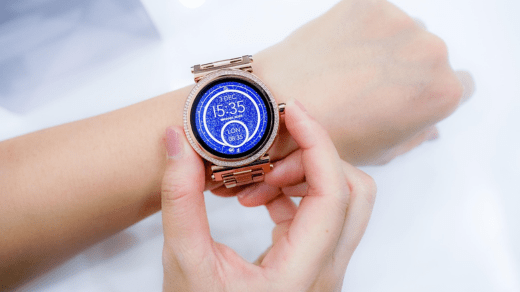Health
Smartwatches for well-being: a revolution for seniors’ health in daily life.

The rise of wearable technology has revolutionized the way we live, and for seniors, this innovation can significantly enhance their health and well-being. Smartwatches designed specifically for seniors are not only practical but also life-changing, offering various features that help seniors monitor their health in real-time. From tracking physical activity to monitoring vital signs, these smart devices play an essential role in improving daily life and fostering independence. In this article, we will explore the benefits of smartwatches for seniors, their key features, and how they can improve the overall quality of life for older adults.
Why smartwatches are essential for seniors
As we age, health concerns become more prominent, and staying on top of well-being can be a challenge. Smartwatches have emerged as a game-changer in addressing these challenges. For seniors, these devices are designed with user-friendly interfaces, offering not only functional health tracking but also enhancing independence, safety, and connectivity. For more models, please visit this page.
Tracking health metrics with ease
One of the key features of smartwatches for seniors is the ability to track health metrics seamlessly. Many smartwatches come equipped with sensors that monitor:
- Heart rate: Tracking your heart rate in real-time can alert seniors to any irregularities.
- Blood oxygen levels: A critical feature, especially during respiratory issues.
- Step count and activity levels: Encouraging movement is vital for maintaining health in older adults.
- Sleep patterns: Ensuring that seniors are getting enough rest is crucial for their well-being.
These features are accessible at a glance, making it easy for seniors to stay informed about their health without the need for complex devices or frequent doctor visits.
Enhancing safety with fall detection
Falls are one of the most significant health risks for seniors, often leading to serious injuries. Smartwatches designed for seniors often come with fall detection technology, which can automatically detect if the wearer has fallen and send an alert to caregivers or emergency contacts. This feature can provide seniors with the peace of mind that help is available when needed, making them feel safer and more confident in their daily activities.
Medication reminders for better health management
For seniors who take multiple medications, keeping track of dosage and timing can become overwhelming. Smartwatches with medication reminder functions help by sending notifications when it’s time to take a dose. These reminders ensure that seniors adhere to their prescribed treatment plans, improving their health outcomes and reducing the risk of medication errors.
Key features of smartwatches for seniors
When choosing a smartwatch for seniors, it’s important to select one that fits the individual’s needs. Below, we outline some key features that make smartwatches especially suitable for seniors.
User-friendly design for easy navigation
Older adults may not be as familiar with technology, so a simple, intuitive interface is essential. Look for smartwatches with large, clear displays, easy-to-read text, and touch-sensitive screens that are easy to navigate. Additionally, voice commands can further enhance the usability of the device, allowing seniors to control the watch without having to touch the screen.
Long battery life for convenience
Seniors don’t want to worry about constantly charging their devices. A long-lasting battery ensures that the smartwatch can function for days without frequent recharging. Smartwatches with long battery life are convenient for seniors, as they don’t have to remember to charge the device daily, which can be a hassle.
Connectivity for staying in touch
A major concern for seniors is staying connected with their loved ones. Smartwatches with built-in communication features such as call, text, and messaging capabilities allow seniors to stay in touch with family and friends easily. Some smartwatches even offer integration with emergency contacts and GPS tracking, ensuring that seniors can be located in case of an emergency.
How smartwatches improve seniors’ daily life
Seniors can benefit from the numerous ways that smartwatches enhance their daily activities. From promoting healthy habits to increasing safety, these devices significantly improve the quality of life for seniors.
Promoting physical activity
Regular physical activity is essential for maintaining health and independence as we age. Many smartwatches come with activity trackers that monitor daily movement and encourage seniors to stay active by setting goals and offering reminders to walk, stretch, or exercise. By encouraging seniors to remain active, smartwatches help improve mobility, strength, and balance, reducing the risk of falls and enhancing overall well-being.
Promoting mental health
The importance of mental health cannot be overlooked, especially in seniors who may face isolation or depression. Smartwatches can promote mental well-being by providing reminders to engage in social activities or cognitive exercises. Some models even offer features for mindfulness, including guided meditation or breathing exercises, which can help reduce stress and promote relaxation.
Enhancing independence
One of the most significant benefits of smartwatches for seniors is the ability to maintain independence. With features like fall detection, medication reminders, and health tracking, seniors can live more confidently and require less assistance from caregivers. This enhanced independence also contributes to improved self-esteem and a more fulfilling daily life.
Selecting the right smartwatch for seniors
Choosing the right smartwatch for a senior can be overwhelming, especially with so many options available. Consider the following factors when selecting the ideal device for a senior:
Health and fitness features
Look for a smartwatch that prioritizes health monitoring, such as heart rate tracking, blood oxygen measurement, and fall detection. These features are essential for seniors to maintain a clear picture of their health.
Ease of use
A smartwatch for seniors should be easy to set up and use. Choose a model with a simple interface, large font size, and easy-to-read display. Additionally, opt for a watch with voice command capabilities to simplify navigation.
Durability and comfort
The smartwatch should be comfortable to wear for long periods and should be durable enough to withstand daily wear and tear. A watch with water resistance is also beneficial, as seniors may wear the device during showers or outdoor activities.
Affordable pricing
While advanced features are essential, the smartwatch should also be within the senior’s budget. Many affordable options are available without compromising on essential features like health monitoring and emergency alerts.
Health
Managing Nerve Pain: Diagnosis and Treatments

What is nerve pain?
Nerve pain can be one of the most uncomfortable and frustrating health issues to deal with. The sensation is often described as burning, stabbing, shooting or a combination of all three. The pain may be chronic, or come and go. This pain occurs as a result of damage or irritation to the nerves of your body and can arise from injuries, medical conditions such as diabetes, infections, and even in some cases following surgery.
Getting the right diagnosis
The next step for most anyone suffering with nerve pain are the next steps to getting properly diagnosed. Many people suffer with pain for years without ever knowing the cause. The way doctors look for the cause of nerve pain is to first perform a physical examination and then start with a discussion about the pain. They are usually interested in when it started, what makes it better or worse, and whether you have other medical problems. They usually do blood work, nerve studies, and/or scans like CAT or MRI to help find the cause of your pain.
Pain management specialist
If they identify a cause they will begin to help you to put together a plan of treatment. And this is when a pain management specialist can really help you. Pain management doctors help to reduce pain and improve quality of life through medical treatment. They use both medicine and patient-centered approaches like behavioral social and emotional support, in decisions related to care. They will work to find the most efficacious treatment options for you.
Treatment Approaches for Nerve Pain
Treatment options for nerve pain may include medication. Some medications decrease nerve sensitivity, while others decrease swelling or muscle spasms. Physical therapy is commonly prescribed to increase strength and flexibility, and lessen pain as time goes on.
For some patients, advanced treatment options with injections, nerve blocks, or electrical nerve stimulation can provide great pain relief. These treatments directly target the affected nerve areas where the pain signals originate, and calm them down. If the pain is due to nerve compression/damage that can be repaired, then surgery may be considered.
Lifestyle Changes That Support Relief
Lifestyle changes also help manage neck pain. Some lifestyle changes that can be helpful include regular gentle exercise, good diet, and good sleep habits. Decreasing stress with activities such as meditation, yoga, or listening to music can be beneficial as stress will generally intensify the pain experience.
Acting early
It’s important to keep in mind that nerve pain will not (may not) go away entirely, but, if it is taken care of appropriately, it can be managed effectively. Early assessment and a customized treatment plan can provide the ability to prevent the pain from worsening and continue on with your daily activities.
If you experience ongoing pain, which does not go away, you should get advice for an assessment. You should not ignore the symptoms or wait too long before getting help to manage them. The earlier you act, the better your chance of finding relief and preserving your nerve health.
Health
Restore Comfort and Mobility with Advanced Non-Surgical Sciatica Treatment
Do you often feel sharp pain that travels from your lower back to your legs? This radiating discomfort, known as sciatica, can make simple movements such as sitting, bending, or walking extremely painful. It usually occurs when the sciatic nerve, which runs from the lower spine down both legs, becomes irritated or compressed.
Ignoring the condition or relying only on painkillers can make the pain worse over time. With modern non-surgical Sciatica Treatment, you can relieve nerve pressure, improve mobility, and achieve lasting comfort naturally.
Sciatica is not a condition on its own but a result of underlying spinal problems. Several factors can contribute to sciatic nerve irritation, such as:
● Herniated or bulging discs pressing against the sciatic nerve
● Narrowing of the spinal canal, also known as spinal stenosis
● Inflammation or tightness in the lower back muscles
● Poor posture and sedentary habits that stress the lower spine
When these factors combine, they compress the sciatic nerve and cause pain, numbness, or weakness that can travel down one or both legs.
Sciatica symptoms can range from mild to severe, depending on the extent of nerve compression. You may experience:
● Sharp or shooting pain in the lower back, buttocks, or legs
● Tingling or numbness that spreads down the leg
● Muscle weakness that makes it hard to walk or stand
● Pain that worsens with sitting or sudden movement
If any of these signs persist, professional Sciatica Treatment can help address the root cause and prevent further damage.
Non-Surgical Sciatica Treatment at ANSSI Wellness
At ANSSI Wellness, we specialise in safe, non-invasive care designed to treat sciatica naturally. Our advanced therapies target the underlying issue rather than masking the symptoms.
Spinal Decompression Sciatica Treatment
This gentle and computer-guided therapy relieves pressure on the sciatic nerve and promotes disc healing.
Physical Therapy for Sciatica
Tailored exercises strengthen spinal muscles, correct posture, and improve flexibility for long-term comfort.
Chiropractic Adjustments
Precise spinal alignments that reduce nerve irritation and restore natural mobility.
Massage Therapy
Focused muscle relaxation that improves blood circulation and releases deep-seated tension.
Heat and Cold Therapy
Alternating warmth and cold to manage inflammation and provide soothing relief.
Lifestyle Guidance
Expert advice on posture, stretching, and ergonomic habits to prevent recurrence and maintain spine health.
Every Sciatica Treatment plan at ANSSI Wellness is customised based on the individual’s condition, ensuring safe and effective recovery without surgery or medication.
Why Choose Professional Sciatica Treatment
Attempting to manage sciatica at home may offer temporary comfort, but without professional care, the condition often returns. Expert-guided non-surgical Sciatica Treatment provides a structured plan that helps you recover faster and prevents long-term complications.
With early intervention, you can regain full mobility, reduce pain, and improve your quality of life naturally.
Begin Your Journey Toward a Pain-Free Life
You do not have to live with sciatic pain or limit your movement. At ANSSI Wellness, our advanced and holistic Sciatica Treatment helps relieve nerve compression, restore spinal balance, and promote lasting relief.
Health
Find the Best Mobility and Hygiene Support for Everyday Comfort

When it comes to providing comfort and convenience for individuals with limited mobility, choosing the right wheelchair with commode, understanding wheelchair price Mumbai, and selecting the right commode chair can make a big difference. These products not only enhance independence but also ensure hygiene and safety in daily use. Among the top choices available today, VisscoNext offers reliable, durable, and thoughtfully designed solutions for home and hospital use.
Why a Wheelchair with Commode is a Smart Choice
A wheelchair with commode combines the benefits of mobility and personal hygiene in one unit. It helps users move comfortably from one place to another and provides an attached commode facility for convenience. This design is especially useful for elderly individuals or those recovering from surgery. VisscoNext offers several models that are easy to clean, lightweight, and built with sturdy materials to ensure long-term use.
Understanding Wheelchair Price in Mumbai
When looking for the best wheelchair price Mumbai, it’s important to consider the quality, features, and materials used. Prices may vary based on whether the wheelchair is manual or electric, and whether it includes additional features like reclining options or detachable commode sections. VisscoNext ensures that customers in Mumbai get affordable products without compromising on quality. Their wide range of wheelchairs suits different budgets and needs, providing great value for money and dependable after-sales support.
Choosing the Right Commode Chair
A commode chair offers a convenient solution for people who find it difficult to access a regular toilet. It is designed to provide stability and comfort while ensuring hygiene. VisscoNext commode chairs come in various designs, from foldable versions to height-adjustable and bedside models, catering to different user requirements. The seats are cushioned for comfort, and the materials are rust-resistant, making them easy to maintain.
Why Choose VisscoNext for Mobility and Hygiene Aids
VisscoNext has built a strong reputation for creating innovative mobility products that make life easier for people with limited movement. Their products focus on comfort, safety, and practicality, ensuring users regain confidence and independence. From wheelchairs with commodes to standalone commode chairs, every design is user-friendly and durable.
If you are looking for reliable and affordable solutions for daily mobility and hygiene, VisscoNext offers the perfect balance between quality and value. Explore their range today and bring comfort, dignity, and convenience to everyday life.
